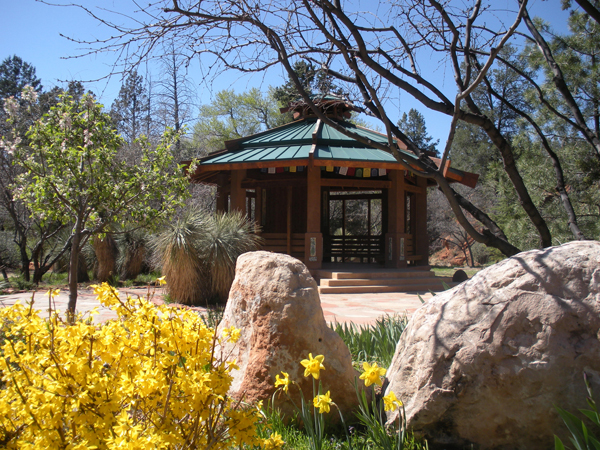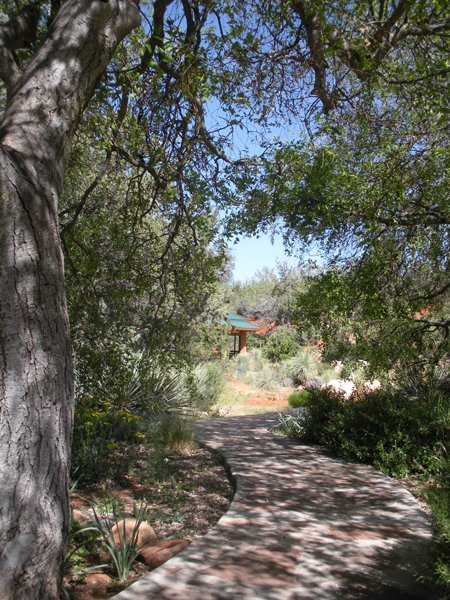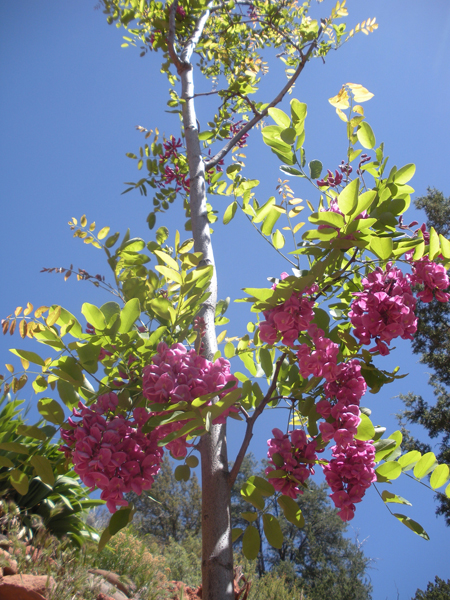The Peace Garden (Shanti Park)
at the Sedona Creative Life Center
The Peace Garden is a Nature Sanctuary established in 2004
by Shirley Caris, the founder of the Sedona Creative Life Center
and Adele Seronde, the founder of Gardens for Humanity.
New: The Benefits of Rosemary
(We have many beautifyl rosemary plants in the Garden)
The Peace Garden is inviting you
to a personal communion with nature
and a joyful celebration of life.
Click here for the Tree Sponsorship page on www.starwheelfoundation.org

April 2013 view of the Pagoda, with Forsythia and Daffodils in bloom.

April 2013 - Entrance to the Peace Garden

April 2013 - Purple Robe Locust in bloom.
After years of patient landscaping and building of the Pagoda and access paths, the Peace Garden was ready in 2012 for the planting of new trees, both ornamental and fruit-bearing trees, that would offer beauty and use to the current and future visitors. In the tradition of an Arboretum and for the benefit of school students and lovers of nature, new trees will have individual tags giving their names and main characteristics.
We are now offering to Friends of the Peace Garden the opportunity to become Sponsors of newly planted trees. Below is a list of the "tree beings" awaiting a gracious sponsor. Your name will be added to the tag of the tree you choose to sponsor. And you can start a spirit relationship with this special tree being, supporting each other, like you do with a dear friend. As of August 2014, 7 trees have already been sponsored.
Traditionally, a new tree would be planted for each child being born, sometimes placing the placenta in the hole beneath the roots. Thus the child would grow up with a personal tree "ally" and a life-time companion offering its shade, flowers & fruits as an expression of unfolding and cycling within the web of life. Later, the grown up person would come to their tree to honor the bonding & communion with the earth and the elements. This is why cutting a tree down makes a hole in the matrix of life; and planting a tree adds richness and celebration to it.
We invite you to be part of the co-creation of life by becoming a tree Sponsor at the Peace Garden.
Please contact Aya, the caretaker of the Peace Garden, to discuss sponsoring a tree. Aya can be reached here or through the Sedona Creative Life Center.
"He/She who plants a tree will live a long life".
September 2013 - List of trees sponsored or donated
• Italian Stone Pine (2). Pinus pinea. Donated by Biddles Nursery (Sedona).
Large pine, native to the Mediterranean region. Stone pines have been cultivated for their edible pine nuts since prehistoric times. When mature, Stone pines develop an umbrella canopy. We have two specimens planted on the cliff side, near the parking lot.
• Vanderwolf Pine. Pinus flexilis Vanderwolf. Donated by ProBuild (Sedona).
Rounded pyramidal conifer with blue-green needles. We call it the "silk Pine" as the needles are surprinsingly soft to the touch. This is a very cozy tree to befriend.
• Chinese Apricot. Prunus armeniaca. Sponsored by Larissa Burley (Los Angeles).
Heavy producing tree with yellow/orange fruits and an elegant branch structure. Late blooming with frost resistant buds. Self-fertile.
• Loquat Gold nugget. Eriobotrya japonica. Sponsored by Aya (Sedona).
Loquats are semi-tropical trees bearing apricot-size fruits with a sweet flavor and orange flesh. Sedona's zone 7 is borderline for this type of tree. We will see if it likes the mild Sedona winter.
• Pomegranate. Punica granatum. Sponsored by Adele Seronde (Sedona).
According to Asian legend, the Pomegranate was the "Tree of Life" in the original Garden of Eden. The tiny beads of fruit, full of precious oil and juice, are brilliant as small rubies and are a great medicine for the red blood cells. This tree is an experiment; we are unsure about its hardiness in Sedona Zone 7.
• Weeping Willow. Salix alba tristis. Sponsored by Karen Albrecht (Pewaukee, Wisconsin).
We call it the "Smiling Willow" as it is planted near the entrance and welcomes the visitors to the Garden. A beautiful specimen planted in 2012 and already twice its original size. It is the sun umbrella for the Fountain Plaza's sitting wall.
• Panamint Nectarine. Prunus persica var. nucipersica. Donated by Anonymous donor. One day, I walked into the Garden and there were these two trees with a note "Can I be part of this lovely garden?", signed: Tree. Thank you!
Heavy bearer of red skin, golden flesh fruits. Ripens early to mid July.
• Flowering Peach. Prunus persica. Donated by Anonymous donor (see above).
Large, semi-double, pure pink, carnation like flowers cover the tree in early spring.
May 2018 - List of trees to be sponsored
• Austrian Black Pine. Pinus nigra. $130.
Originating from the Mediterranean regions, this large coniferous evergreen is a fast grower with an exceptionally dark green foliage and a pyramidal shape. Grows to 60 - 90 ft. tall. This pine tree can be long lived, with some trees over 500 years old.
• Three Apricot trees. Prunus 'Moorpark" & Prunus armeniaca. $75 each.
Planted in a triangle, next to the entrance of the Peace Garden, the apricot trees are symbols of the food abundance we would like the Grden to provide in a few short years for this and the next generations. Apricots have been cultivated in Armenia (the botanical name is Prunus armeniaca or Armenian plum), Persia and Egypt since most ancient times.
The Chinese associate the apricot with education and medicine. The association with medicine in turn comes from the common use of apricot kernels as a component in traditional Chinese medicine, and from the story of Dong Feng, a physician during the Three Kingdoms period, who required no payment from his patients except that they plant apricot trees in his orchard upon recovering from their illnesses, resulting in a large grove of apricot trees and a steady supply of medicinal ingredients. The term "expert of the apricot grove" is still used as a poetic reference to physicians.
We have two Prunus “Moorpark’ and one Prunus armeniaca.
• Catalpa. Catalpa speciosa. $95.
A beautiful ornamental with heart-shaped leaves and showy white/yellow trumpet-shaped flowers. Due to its large leaves, the Catalpa provides dark shade and is a popular habitat for many birds. It is also called the "Indian Bean tree" because of its long, slender bean pods. We now have another large 'parent' Catalpa on the side of the Pagoda and two seedlings forming a family triad with the opriginal Catalpa. These trees bring in a semi-tropical feel to the Garden.
• Kwanzan Cherry. Prunus serrulata. $75.
Also called the Japanese Flowering tree (or "Sakura"), this is one of the showiest of all flowering trees. In Japan, there is a centuries-old tradition of gathering under the blossoming cherry trees to celebrate the coming of the springtime. The Kwanzan Cherry is also a perennial symbol of the beautiful but ephemeral nature of all life.
• Southern Magnolia. Magnolia grandiflora. $110.
Magnolia is an ancient genus. Appearing before bees did, the flowers evolved to encourage pollination by beetles. To avoid damage from pollinating beetles, the carpels of Magnolia flowers are extremely tough. Fossilised specimens of Magnolia acuminata have been found dating to 20 million years ago. Beautiful white flowers are displayed in summer.
• Rich Quince. Cydonia oblonga ‘Rich’s Dwarf’. $75.
An attractive fruit tree producing large fruits. This small-sized 15-20' tree has white to pink spring flowers. It was selected for its extra large, fragrant fruit that gradually ripens to a rich golden-yellow. Excellent for jellies.
• Fuji Apple. Malus domestica Fuji. $50.
Soon after its introduction to the U.S. in 1980, the Fuji apple tree became a favorite because of the unique combination of flavor, sweetness and crisp texture of its fruits.
• Purple Robe Locust. Robinia ambigua Idahoensis. $80.
An outstanding shade tree with profuse purple blooms in spring. The strong & sweet fragrance of the flowers, smelling like honey & roses, attracts insect pollinators in droves. Displays a beautiful reddish-bronze foliage.
• Lombardy Poplar. Populus nigra 'Italiana'. $95.
The Lombardy poplar is a very tall, rapidly growing tree with a distinctively columnar shape, often with a buttressed base. The unusual, upward-sloping branches form a stunning, vertical outline. Songbirds particularly love these trees for nesting and shelter.
• Golden Rain Tree. Koelreuteria paniculata. $75.
A native of Eastern Asia, the Golden Rain tree owes its name to the aesthetic beauty of its yellow 4-petaled flowers, as well as to the appeal of its leaves and seed pods. Planted in the North-East corner of the garden, this tree, when in bloom, extends a yellow welcoming to the people driving through the parking lot.
• Birch trees. Betula papyrifera. $80.
A cluster of 4 white birch trees is a reminder of this traditional tree being, widespread worldwide from Asia, to Europe to America. Many are the uses of the Birch tree by different cultures, from carpentry to medicine to drinking the sap. The national tree of Finland.
• Oak trees. Quercus gambelii. $50 each.
We planted 2 small size traditional oaks near the sycamore grove. They are a fast growing hybrid, heavy acorn producers, that will soon be a reminder of the powerful medicine of the traditional oak tree, the sacred tree of the Druids.
• Cottonwood trees. Populus fremontii. $110. $175.
The Peace Garden is hosting 2 new cottonwoods to complement the magnificent old "mother" cottonwood already gracing the South bank of the dry creek. We have planted 2 new members of the family in 2008 and 2011; there are thus 2 different sizes of cottonwood trees seeking sponsors.The largest cottonwood is already 25 feet high.
• Blue Spruce. Picea pungens “Glauca’. $125.
The Colorado blue spruce is a conical-shaped evergreen tree often used for Christmas trees, particularly in the eastern United States and Europe. It is the official state tree of both Colorado and Utah. The species generally reaches a height of 65-115 feet at maturity with a diameter of 2-3 feet. It has a narrow, pyramidal shape and cone-shaped crown. While Blue Spruce grows relatively slowly, it is long-lived and may reach ages of 600-800 years.
• Ponderosa pine. Pinus ponderosa. $110.
Large pine tree distinguished by its bark with exfoliating plates and its long needles growing in tufts. Prevalent in the native forest around Flagstaff. The official state tree of Montana. We planted it on the bank of the dry creek. It is now a well-etablished, noble pine tree.
• Black Bamboo. Phyllostachys nigra. $75.
A cluster of tall, black bamboo shoots preparing to become a "bamboo grove". With jet black culms and feathery green leaves, this is a sought-after bamboo for wood working. New culms emerge green every spring and gradually turn black in 1-3 years. There is always a contrast of light and dark culms balanced by slender, dark green leaves.
• Linden tree. Tilia cordata. $150.
A traditional medicinal tree, very revered in Europe where it has been planted in villages & towns for its healing shade. It also makes a vey soothing & calming tea.
• Chestnut tree. Castanea dentata. $125. [Just planted in the springtime].
The American chestnut was the most important food and timber trees species in the Eastern hardwood forest. It was almost completely destroyed by an exotic "blight" fungus but is now making a strong comeback with hybrid varioeties that are disease-resistant. The chestnut tree is a majestictree-being producing large, sweet nuts. A versatile and prized source of food, perfect for roasting on an open fire.
• Two Pecan trees. Carya illinoinensis varieties. $150 each.
We have planted 2 large Pecan trees, already producing, in the "nut forest" part of the Garden. "Pecan" is from an Algonquian word variously referring to pecans, walnuts and hickory nuts, or more broadly to any nut requiring a stone to crack. Pecan nuts have a rich, buttery flavor. They can be eaten fresh or used in cooking, particularly in sweet desserts (think "Pecan pie").
• Two Walnut trees. Juglans regia varietries. $150 each.
Two noble and useful trees that will reach to 50' tall. In the back forest. Following full ripening, the removal of the husk reveals the wrinkly walnut shell containing the walnut itself. Two segmented, the walnut resembles the two halves of the human brain. Walnuts are late to grow leaves, typically not until more than halfway through the spring. They secrete chemicals into the soil to prevent competing vegetation from growing. The walnut is nutrient-dense with protein and essential fatty acids.
• Asian Pear tree. Pyrus pyrifolia "shinko". $125.
The Asian pears are not generally baked in pies or made into jams because they have a high water content and a crisp, grainy, slightly gritty texture, very different from the European varieties. They are commonly served raw and peeled. The Asian pears tend to be round, large and fragrant. They can last for several weeks or more in a cold, dry place. Due to their beauty and the large size of the fruit, the pears tend to be served to guests, given as gifts.
• Mulberry tree. Morus alba & Morus rubra. $75.
A female (fruit-bearing), fast growing tree producing a great abundance of sweet berries. We have planted both a white variety (Morus alba) and a darker variety (Morus rubra). When the Mulberry trees are bearing fruit, it is a great festivity for children, kids and families to pick the harvest and enjoy it on the spot.
• Four Plum trees. Prunus domestica. $75 each.
Along "Plum Alley", we now have several plum trees. Plums may have been one of the first fruits domesticated by humans. Three of the most abundant cultivars are not found in the wild but only around human settlements. When it flowers in the early spring, a plum tree will be covered in blossoms, and in a good year approximately 50% of the flowers will be pollinated and become plums. The plum blossom or meihua, along with the peony, are considered traditional floral emblems of China.
• Jujube tree. Ziziphus jujuba. $75.
A native of China producing datelike fruits that can be eaten fresh or dry. Planted two years ago, our Jujube tree is already a tall, elegant tree towering in the orchard.
• Three Blue Atlas cedar trees. Cedrus libani atlantica. $100 each.
From North Africa. These blue cedars shade the cliff promenade area overlooking the Pagoda. They were planted in a triangle for a special accent on the cliffside.
• Eucalyptus tree. Eucalyptus microtheca 'coolibah'. $175.
Originating from Australia, this fast-growing tree has blue-green, ribbon-like, lanceolate leaves 8 in. long. The Eucalyptus coolibah is a wide-spreading tree (often wider than tall) and reaches up to 20 metres (66 ft) in height. We planted it for the fragrance and the medicinal properties of the eucalyptus essential oil.
• Gingko tree. Gingko biloba. $175.
The "Maidenhair" tree is a survivor from prehistoric times. It is found in fossils dating back 270 million years. Native to China, the tree is widely cultivated, and was cultivated early in human history. The shape of the leaf is characteristic and has an "ancient" feel to it.
The list of medicinal uses of Ginkgo is very long. This may be because this tree has been around for so long. Ginkgo trees can also ive as long as a thousand years.
Visit the Peace Garden to become a Peace Garden Tree Sponsor.
Contact Aya, the garden's caretaker, for a Tree Sponsorship appointment:
aya (at) starwheels.com
Contact:
Sedona Creative Life Center, 333 Schnebly Hill Road, Sedona, Arizona 86336.
www.SedonaCreativeLife.com


